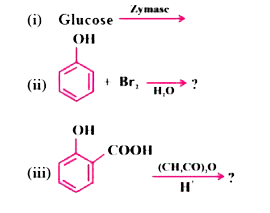Phenol +CH2OAlkali−−→A , Here, [A] is :
O & p- Hydroxy benzyl alcohol
m - Hydroxy Benzaldehyde
Aniline
None of these
The correct Answer is:A
To solve the question, we need to determine the product (A) formed when phenol reacts with formaldehyde (CH₂O) in the presence of an alkali.
1. Identify the Reactants:
The reactants are phenol (C₆H₅OH) and formaldehyde (CH₂O).
2. Understand the Role of Alkali:
In the presence of an alkali, phenol will deprotonate to form the phenoxide ion (C₆H₅O⁻). This is because phenol is slightly acidic and will react with the base to form the corresponding phenoxide ion.
C₆H₅OH+OH⁻→C₆H₅O⁻+H₂O
3. Resonance Stabilization of Phenoxide Ion:
The phenoxide ion is resonance-stabilized, which means that the negative charge can be delocalized over the aromatic ring. This delocalization increases the nucleophilicity of the ortho and para positions.
4. Nucleophilic Attack on Formaldehyde:
The nucleophilic oxygen in the phenoxide ion can attack the electrophilic carbon in formaldehyde. The attack will primarily occur at the ortho and para positions of the aromatic ring.
C₆H₅O⁻+CH₂O→C₆H₅(OH)CH₂O⁻
5. Proton Transfer and Final Product Formation:
After the nucleophilic attack, a proton (H⁺) will be extracted from water, leading to the formation of a hydroxymethyl group (-CH₂OH) at the ortho and para positions of the phenol. This results in the formation of ortho and para hydroxybenzyl alcohols.
The final product A can be represented as:
C₆H₄(OH)(CH₂OH)(Ortho and Para Hydroxybenzyl Alcohol)
Conclusion:
The product A formed from the reaction of phenol and formaldehyde in the presence of alkali is ortho and para hydroxybenzyl alcohol.
The reactants are phenol (C₆H₅OH) and formaldehyde (CH₂O).
In the presence of an alkali, phenol will deprotonate to form the phenoxide ion (C₆H₅O⁻). This is because phenol is slightly acidic and will react with the base to form the corresponding phenoxide ion.
The phenoxide ion is resonance-stabilized, which means that the negative charge can be delocalized over the aromatic ring. This delocalization increases the nucleophilicity of the ortho and para positions.
The nucleophilic oxygen in the phenoxide ion can attack the electrophilic carbon in formaldehyde. The attack will primarily occur at the ortho and para positions of the aromatic ring.
After the nucleophilic attack, a proton (H⁺) will be extracted from water, leading to the formation of a hydroxymethyl group (-CH₂OH) at the ortho and para positions of the phenol. This results in the formation of ortho and para hydroxybenzyl alcohols.
C₆H₄(OH)(CH₂OH)(Ortho and Para Hydroxybenzyl Alcohol)
The product A formed from the reaction of phenol and formaldehyde in the presence of alkali is ortho and para hydroxybenzyl alcohol.
Similar Questions
Knowledge Check
Acetone CH3MgI−−−−−→Dry ether intermediate H2O−−→ 'X' . Here, [X] is :
ACH3OHBCH3−CH2−OHCCH3−CH(OH)−CH3D(CH3)2C(OH)(CH3)(I)CH2=CH−CH=CH2
(II)ΘCH2−CH=CH−⊕CH2
(III)⊕CH2−CH=CH−ΘCH2
Among, these, which are canonical structures ?AI and IIBI and IIICII and IIIDallR−O∣∣C−OH[?]−−→RCH2−OH
Here reagent isALiAIH4BNaBH4CBoth (1)& (2)DRed P/HI
Write correct order of acidic strength of following compounds:
(a)NO2−CH2−O∣∣C−O−H
(b)F−CH2−O∣∣C−O−H
(c)Ph−CH2−O∣∣C−O−H
(d) CH3−CH2−O∣∣C−O−H
View SolutionWrite correct order of acidic strength of following compounds:
(a)CH3−CH2−C∣FH−O∣∣C−O−H
(b)CH3−C∣FH−CH2−O∣∣C−O−H
(c)C∣FH2−CH2−CH2−O∣∣C−O−H
View SolutionFill in the blanks :
(i) Glucose zymase−−−→

(iv) CH3CH3∣CHOCH2CH3HI−−→?
(v) Phenol + Zn (dust) →
Phenol + Na →
(vii) R2CHOH+HCI+ZnCI2(anhydrous)→R2CHCI+.......
(viii) R−CHOH−R[O]−−→
(ix) CH3−OH∣CH−CH3SOCI2−−−→CH3−CICH−CH3+
(x) CH3−CH2−OHBleaching powder−−−−−−−−−→
View SolutionCH2=CH2O3−−→XH2O/Zn−−−−−→Y[O]−−→Z , Z is
View SolutionIn the reaction
PhenolNaOH−−−→(A)CO2+HCl−−−−−−→140(B) here B is
View Solution
